Recommended tours...
It is with great pleasure to welcome you to PRAGUE. Prague is the most important
Czech urban reservation and since 1992, its historical centre on area of 8,66
square kilometres has been on the UNESCO list of world cultural and natural heritage.
Occupying an area of 497 square kilometres, the 57 boroughs of the capital of
the Czech Republic has a population over 1,2 million. The city is situated 235 metres
above sea level, straddling the river Vltava with 18 bridges. Beautiful Prague has
many affectionate attributes, one of which - the city of hundred spires - is untrue,
for their actual number is arround 500. Prague has over 60 theatres and clubs,
40 concert halls and rooms, 80 art galleries, 30 museums and 30 cinemas. The combinated
area of its parks and gardens is around 870 hectares.
You may rest assured, that all the directions, duretion times of recommended
trips etc. may be customized to fit the customer’s wishes. All trips are
provided by chauffeur - driven de luxe cars, fully air conditioned. Pick - up from your
hotel at your desired time is our priority. All the guides are licensed for Prague
and Czech Republic and their guiding abilities (including knowlidge of history,
personal approach, sence of humour) have been checked personaly by management of
Heritage travel. All tours and trips are available in English, German, French, Italian,
Spanish, Portugese and Russian, in other languages at client’s request.

DEAR FRIENDS,
It is with great pleasure to welcome you to Prague. Many people come to our city
with no idea of what to do when they arrive, but HERITAGE TRAVEL agency is designed
to fit your individual taste. If you have a problem deciding what to do or where to,
bring your problem to us. We will assist you in any way to make your visit easier
and to make you feel at home. If you are interested, please write us a letter before
you arrive letting us know your particular interest so that we can accommodate your needs.
We are sure we have an individual program that will fit your pocket.
1. Panoramic tour of Prague - a city tour by car or on foot
/duration ca 3,5 - 4 hours/
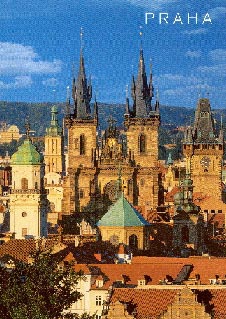
Presents major and most attractive places in historical centre of Prague. During
the tour you will get a good overview of the „Golden City". The tour including
Prague Castle, The Lesser Town, Old Town, the Jewish Quarter and New Town.
Prague so offen called poeticly Town of Golden Spires really offers to you unforgettable
experience and impressions of its medieval charm in its centre... Durig the tour you will
learn historical facts and dates combined with venerable legents and fairy tales about
old Prague. By the end of the tour you can enjoy Czech cuisine in some of best local
restaurants, we can organize for you reservation and help you by the choice of theese
restaurants.
2. Follow in Bohemian’s kings footsteps - royal route
/duration about ca 3 hours/
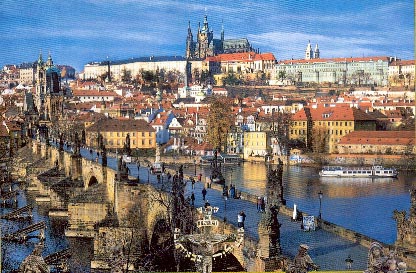
We would like to invait you to a enjoyable walk round the Old Town, Little Quarter,
Prague Castle. The tour starts at the Powder Gate, along one of oldest streets in
Prague, Celetná street lined by Baroque and Rococo houses with unusal house signs.
At the end of Celetná street you will fascinate by one of most charming squeres of
Prague, Old Town squere with its engaging houses, and Old Town Hall with the famous
Astronomical lock, where centrepiece of the show that draws a crowd of spectators
every strikes the hour is the procession of 12 Apostles. The royal route then will lead
us along the Karlova street to Charles bridge, oldest bridge in „Golden Prague" with
its lovely 30 statues of saints. Charles bridge is most familiar and celebrated structure
of „hundredsspires city" and from here presents undoubtedly one of picturesque
views of Prague. The walk now follows over bridge and then under the Little Quarter
bridge towers to Mostecka street to Little Quarter squere with its dominant, stateliness
St Nichola’s church, where the procession of kings passed the church to the sound of
its bells ringing. Our tour leads now to nicest narrow street of renaissance Prague, where
many of houses have a splendid selection of heraldic beasts end emblems. At the end
this street we turn right and walk up the Castle ramp, which leads us to Hradčanské
squere. The route ends at the Castle’s Matthias Gate. The procession ended with the
coronation held at St Vitus’s Cathedral.
3. Jewish heritage tour
/drivig and walking tour, duration cca 4 hours/
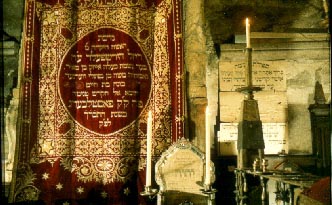 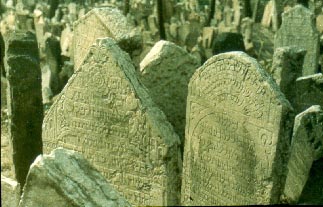
On this tour we would like to give you a general overview of the former old
ghetto and its fascinating history, where settled two distinct Jewish communities in
Prague’s Old Town: Jews from the West had settled arround the Old - New Synagogue,
Jews from Byzantine Empire around the Old Shul (on the site of today’s Spanish Synagogue).
The two settlements gradually merged and were confined in an enclosed ghetto.
During this tour we will wisit Old - New Synagogue, the gothic hall with its distinctive
crenellated gable has been a house of prayer for over 700 years, Old Jewish Cemetery,
Pinkas synagogue-now serves as a memorial to the all the Jewish Citizens of Bohemia and
Moravia, who were imprisoned in Terezín concetration camp and later deported to various
Nazi termination camps, Klausen synagogue houses now exhibition of Jewish traditions
and customs; Maisel synagogue with exhibition of "History of Jews in Bohemia and Moravia";
Spanish Synagogue with nice ornate interior built in Moorish style. Then we will drive
to New Town, where next to high T.V.tower (not easy to overlook, hight 670 feets) is
fragment of second oldest Jewish cemetery in Prague from 1787, damaged during communist
regime, in the end we’ll visit New Jewish Cemetery, used from 1891 and still in operation,
where you can see grave of Franz Kafka.
4. Jewish Town of Prague /walking tour, cca 2,5 hours/
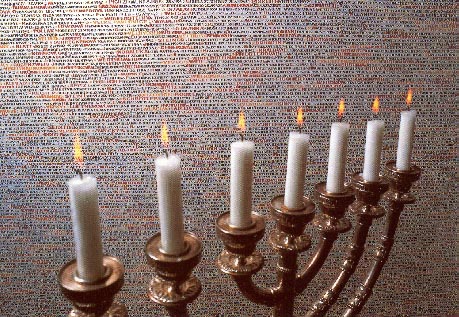
During this tour we would like to show the whole area of former ghetto and give you
a well - knowing commentary of its woefull history. We will visit Spanish synagogue,
Maisel synagogue, Pinkas synagogue, Old Jewish Cemetery, Klausen Synagogue, The Ceremonial
Hall (Prague Burial Society - Hevrah Kaddishah, founded 1564), Old New Synagogue.
5. Prague by night
/duration cca 2,5 hours - by car and short stops for walks/
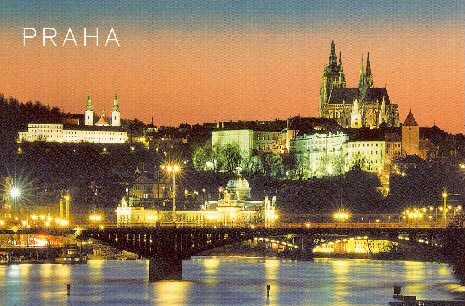
A panoramic tour through Prague presents "Golden City" as a one of most charming and
romantic cities in the world. You will see all the most beatifully - lit sites and monuments
from other dimension: Prague Castle and and moving view from Castle ramp, Little
Quarter and its tortuous somber streets, Charles bridge, Old Town Square with its almost
fairy - tale character and embankment of Vltava river with reflection of many flood -
lights and illuminatedadvertisings creates nice atmosphere. In the end you will be
under a spell of a impressive view of Prague Castle beaming on the hill - top as a stately
witness of ancient history of "Golden Prague". After this tour we can arranged for you
itinerary for nigh - life in Prague, keep you in pleasant mood till time of your departure,
You are on the holiday though, arn’t you!
6. Prague by night and Křižík fountain
/duration cca 2.5 hours - by car/
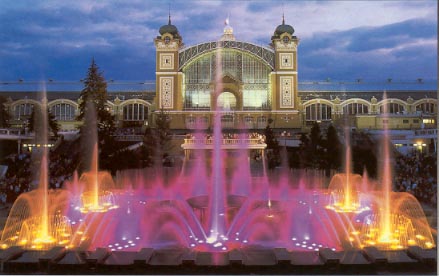
A panoramic tour through Prague combined with a visit of water - light show on fountain,
which became one of the most sought for cultural places not only in Prague, but also
in Czech Republic. We can guaranteed to you, you will be under a spell of a range of
varied color effects creating a fairy tale atmosphere. The fountain itself and all the
running aquatic and stage perfonmances gained already the attention of many spectators
of all over the world. The programs are made both from the works of world’s best known
classical composers and from the works by contem porary authors.
7. Prague by night - dinner on the boat
/duration 3,5 hours - by car/
On this tour you will get a unique opportunity to see charm of Prague from a river
dimension. The view from a board of ship to hill - top with stately Prague Castle and
Charles Bridge and spires of St Nicholas Church of Little Quarter is magnificent. During
the cruise is a buffet dinner at disposal to you to the accompaniment of live band music
programme.
RECOMMENDED TRIPS OUTSIDE OF PRAGUE
1. Karlštejn Castle /a half day trip by car, 18 miles SW of Prague/
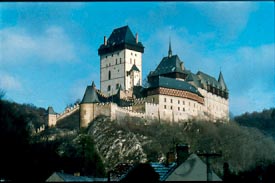
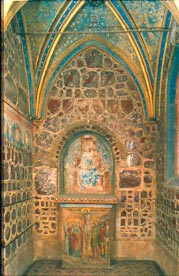
Most popular destination in the Czech Republic after Prague, this tour is a easy half
day trip for thouse interested in getting out of the city. The castle was founded by
Charles IV as a country retreat, a secure treasury for the imperial crown jewels and
a symbolic expression of his divine right to rule the Holy Roman Empire. It stands on
a limestone crag above the River Berounka. As you approach the castle, little can prepare
you for your first view: a spectacular, Disney - like castle perched high on a hill
surrounded by lush forest and vineyards and meadows. A venerable legend says, that women
were not allowed to stay in the castle overnight. On the way up to the castle you will
be surprised with a number of bright choice of souvenir stands selling Bohemian Crystal,
hand made craftmanships, marionettes etc. As cars are not allowed to accces to the castle,
there is the option of using a horse - drawn carriage or a taxi to the hill - top of the
castle.
2. Křivoklát Castle /a half day trip by car, 27 miles W of Prague/
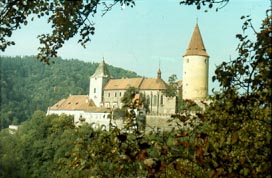
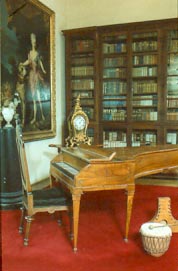
Less crowded, and much less touristy than its neigbour upstream at Karlštejn.
Křivoklát is the perfekt destination for thouse of you, who like see romantic
czech countryside and relaxing drive through the Protected Landscape Area Křivoklátsko
covered by woods and meadows. Křivoklát was originally a hunting lodge beloing to the
early Přemyslid princes and the seat of the royal master of hounds. Charles IV spent some
of his childhood here.
The royal palace is on the eastern side of the roughly triangular castle and is
dominated by the Great Tower, 42 m (130 ft) high. On the first floor thre is a vaulted
Gothic hall, reminiccent of the Vladislav (jousting) Hall in the Royal Palace at the Prague
Castle. Also of interest is the chapel, which has a fine Gothic altar carving. On the
second floor is a beatifull castle library with many family portraits and nice funiture.
The Habsburgs converted castle into a state prison, in the castle prison called dungeon
is a grim assortment of instruments of torture. This tour give you a pleasant combination
of relax and knowledge.
3. Chateau Konopiště /a half day trip by car, 30 miles S of Prague/
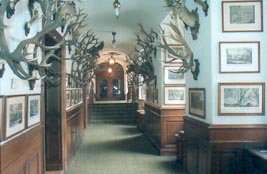
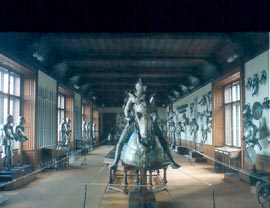
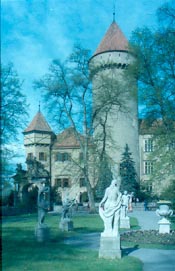
From our own long experience this tour is one of most popular half day trips outside
of Prague. The Konopiště Chateau is really one of most beautiful and graceful Czech
Chateaux surrounded by lovely preserve and lake. Though it dates back to the 13th century,
this moated castle is essentially a late 19th century creation. In 1887 Konopiště was
bought by Archduke Franz Ferdinand, who later became heir to the Austrian throne. It was
his assassination in 1914 in Sarajevo that triggered of World War I. His Czech wife,
Countess Sophie Chotek was assassinated with him. To escape the Habsburg court’s snobbish
disapproval of his wife, Ferdinand spent much time at Konopiště. He amassed fine collection
of arms, armour and Meissen porcelain, all on display in richly furnished interiors. The
main hall is a testament to the Archduke, who reportedly bagged some 300 000 animals -
that translates to an incredible 20 animals a day, every day for 40 years! Only 1% of this
total hunting collection is on display at the castle, and it still ranks as one of the
largest hunting collections in Europe. Most interesting is the third route takes you
through Ferdinand’s private rooms where you can learn a story of tragedy of one family...
On the way to Prague we drive across a very romantic countryside and you will see a valey
of Vltava river.
4. Kutná Hora - UNESCO listed town
/duration cca 5 houres by car - 45 miles E from Prague/
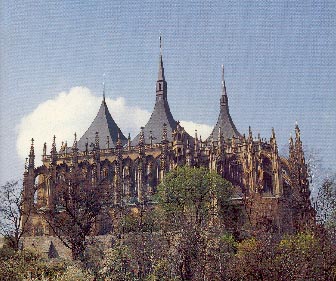
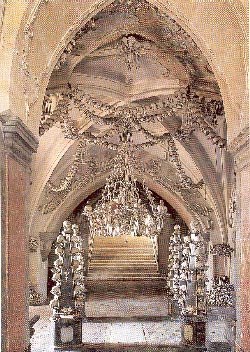
On this trip you will see one of our most picturesque historical towns that graw fantastically
from the silver deposits beneath. The town originated as a small mining community in the second
half of the 13 th century. When rich deposits of silver were discovered, the king took over the
licensing of the mines and Kutná Hora became second most important town in Bohemia. In 14th century
5 to 6 tonnes of pure silver were extracted here yeach year making the king the richest
ruler in Central Europe. The Prague groschen, a silver coin that circulated all over Europe,
was minted here in Italien Court, strongly fortified was also the ruler’s seat when he visited
the town. The town’s main attraction is the enormous St. Barbara’s Cathedral, begun in 1380 by the
workshop of Peter Parler, also the architekt of St Vitus‘s Cathedral. Cathedral of St Barbara with
its three massive and tent - shaped spires rising above a forest of flying buttresses, is a
wonderfull example of Bohemian Gothic. Walking through the little streets of this town
you will feel like as you stopped in time, in time of its "silver elation"... Howewer,
a visit to Kutná Hora isn’t complete withhout a short stop to Kostnice, "the Bone Church".
The church’s interior is decorated by bones came from victims of 14 th - century plague
and 15 - century Hussite wars, here you will see crosses of bone, columns of bone, chalices
of bone, and even a chandelier, which incorporate every bone in the human body.
Also, a guided visit to the top floor (30 m) of the original 500 m deep mine from 15th
century is worth the trip.
5. Český Krumlov - UNESCO listed town
/whole day trip - 117 miles S of Prague/
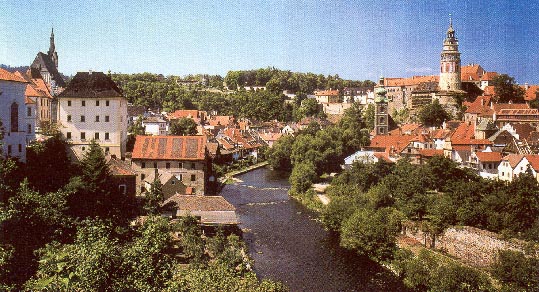
If you will have time on your visit to the Czech Republic for one excursion only,
seriously consider making Český Krumlov. One of Bohemia’s prettiest towns, Krumlov is a
living gallery of elegant Renaissance - era buildings housing charming cafes, pubs,
restaurants, shops, and galleries. This town is becoming more and more goal of tens of
thousands of visitors from home and abroad.
This is no wonder since it has preserved the character of an ancient mediaeval town
once seen, is never forgotten. And it is its uniqueness which caused it to be declared
a protected urban reservation in 1963. Český Krumlov importance as an exceptional
historical monument was emphasided also in 1992 when the town was entered in the UNESCO
register of monuments of world signifikance, deserving extraordinary care, attention and
support. The name was derived from the old German "krumben ouwe" meaning a place on a
crooked - shaped meadow. From its foundation in the mid 13th century until 1302 Český
Krumlov, with its castle was held by the noble family of Vítkovci; thereafterit passed
to Rožmberks, under whom the old fortified castle became a magnificent Renaissance palace;
from 1622 it belonged to a German noble family , the Eggenbergs; and after their line
became extinct it passed to the Princess Schwarzenberg. The main dominant of this town,
Chateaux Český Krumlov with some 300 rooms laid out round four courtyards, is lavishly
furnished with furniture, tapestries pictures and porcelain. During our tour we will walk
across the whole historical centre and we’re sure, after this trip the romantic beauty
of this small town in South Bohemia will keep in your mind still long time after your
departure... On the journey back to Prague is possible stop in České Budějovice, known
as a Budweis under the Habsburgs and famous home town of the original Budweiser brand
beer. We can have a look on charming renaissance square, the square contains the ornate
Fountain of Sampson, an 18 - century water well that was once the town’s principal water
supply. In spite the drive to Prague takes 2,5 hours, you will see many nice villages
and lovely countryside of Southern Bohemia. /9 houres trip, we can arrange as a two days
trip too/
6. Karlovy Vary - Carlsbad
/duration cca 8 houres by car - 78 miles W of Prague/
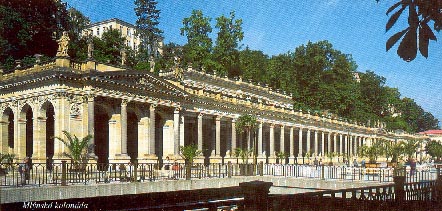
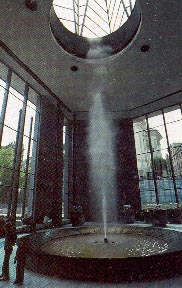
We would like to invite you for this trip to most famous Bohemian spa. It is named for
Emperor Charles IV, who allegedly happened upon the springs in 1358 while on a hunting
expedition. As the story goes, the emperor’s hound - chasing a harried stag - fell into
a boiling spring and was scalded. Charles had the water tested and, familier with spas
in Italy, ordered baths to be established in village of Vary. The spa reached its heyday
in 19th century, when royalty came here from all Europe for treatment. The long list of
those, who "took the cure" includes Goethe, Schiller, Beethoven, Chopin, even Karl Marx,
when he wasn’t decrying wealth and privilege, spent time at the resort and wrote some of
Das Kapital here between 1874 and 1876. We will visit Sprudel Colonnade with the Sprudel
(Vřídlo), the oldest and hottest (73°C / 163° F) of the springs of Karlovy Vary. This is
a geyser - type spring which propels a stream of water as thick as man’s arm to a height
of up to 12 m / 40 ft. There are between 40 and 60 bursts of varying strenght every minut,
with a total daily flow of 3 million litres / 660 000 gallons! Then we’ll come to Mill
Spring Collonade, a long hall lined by Corinthian columns containing the Rose Spring,
Prince Wenceslas Spring, the Libussa Spring and the Mill Spring. The temperature of these
springs ranges between 42°C / 108° F and 60°C / 140°F. Altogether there are about 60 springs,
but only 12 of them are used. After a walk through spa area is possible visit world - known
glass manufakture Moser or the manufacture of herb liquere Becherovka /since 1805/. For the
entertainment of its visitors Karlovy Vary has a theatre and well - known orchestra and
there is an international festival in alternate years and an annual festival of tourist
film (Tourfilm).
7. Mariánské Lázně - Marienbad
/by car 29 miles SW of K. Vary, 100 miles W from Prague,
duration cca 8 hours/
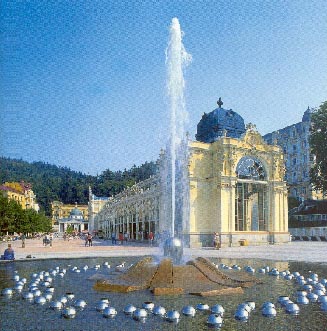
There is no more beautiful spa in the entire world, proclaimed a one of famous guest,
inventor Thomas Alva Edison, in 1911, commenting on Europe‘s most oustanding, and for that era
most modern, health resort. Mariánské Lázně lies in a wooded valley at about 630 m (1953 ft)
above sea level, and is literally bubbling with rich mineral waters. There are 40 springs
within the relatively small area of town, and 100 in the immediate vicinity. There is a
refreshing subalpine climate, ideal for the area’s beautiful forests and parks, and a
electrifying, freeform collection of romantic, splendid architecture from the second half
and turn - of the 19th century Art Noveau hotels, pensions, colonnades, and promenades.
The New Colonnade of this town, 180 m long, ranks among the most monumental in Bohemia.
The Singing fountain, a twentieth century addition, is a true landmark. The healig effects
of the local mineral springs have been known since the 17th century. The place was property
of the Teplá Premonstratensian monks who established an early health resort, or "Kurhaus"
in 1805. The name Mariánské Lázně was introdused in 1808, and spa status was achieved
a decade later. Historical records mention a total of seven resorts in 1815, providing spa
treatment to 187 visitors to the town. The town grew with the increasing number of visitors
to the spa. Famous personages from all over of the world came for tratment, pleasure,
politics, and bussiness. English King Edward VII liked town so much that he returned nine
times. Today we would probably read the guest book without much noticing the names of many
sultans, and other aristocrats who visited here, but some name would catch our eye even
today: Mark Twain, Kipling, Dostojevsky, Frederick Chopin, Strauss, R. Wagner, S. Freud,
Franz Kafka, to name just a few.
With the great pleasure we would like to invait you for this trip a give you a unique
opportunity enjoy glamour of this town in West Bohemia.
8. Telč /duration cca 10 hours by car - 93 miles SE of Prague -
there is a option visit
Telč on the way to Vienna - see European
chauff. driv. tours/
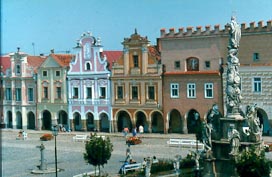
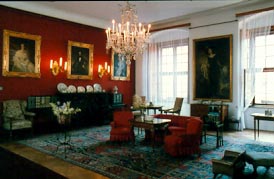
The charming little old - world town /5000 inhab./ lies on the east side of the basin
of the river Dyje in the undulating landscape of the southern Bohemio - Morevian Highlands
Českomoravská Vrchovina. Telč is one of the few towns in Europe that can boast of not being
reconstructed since its original edifices were built. It now enjoys the honor of being
a United Nations (UNESCO) World Heritage Site. Telč, whose heyday was in the 16th century
under the rule of the Lords of Hradec, ranks together with Český Krumlov /see tour number
5/ as one of the finest architectural ensembles in the whole country. The great glory of the
town is the market square, unique in its authenticity and unity, with its picturesque
gabled houses and arcades of the Renaissance and Baroque periods. At the east end of the
square are Marian Column (1716 - 1717) and two Baroque fountains. North - western end of the
squere is closed of by the Castle (Zámek), a handsome Renaissance building of 1553 - 1580 with
a richly appointed interior (stucco decoration, carved ceilings) and collections of pictures,
weapons and hunting trophies. To the rear are carefully tended Renaissance gardens. The two ponds
surrounding the town centre formed part of Telč‘s medieval defences, earning the town the name
"Water Lily". With great pleasure we would like you invait for this trip, you wiill feel, as you
get into period of Renaissance...
9. TŘEBOŇ /duration cca 9 hours by car - 92 miles S of Prague -
there is a option visit Třeboň on the way to Vienna - see European
ch. dr. tours/
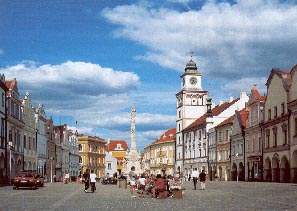
The town of Třeboň lies in the heart of the Třeboň basin, an extensive area of
sotheastern Bohemia of about 700 sq km. This rolling countryside, with its thick forests
and innumerable ponds and lakes, forms a special environment of its own. Since colonization
of this area began in 12 th century, the local inhabitants have gradually shaped the
coutryside to their own needs, with optimum placement of villages and a enormous systém of
water regulation. The building of artifficial creeks and ponds, spread out over several
periods, has given the Třeboň are a unique form, for which it has been declared a UNESCO
Biosphere Reserve. Třeboň also has a rich history, visible in the form of numerous
architectural and cultural monuments. The beautiful old town of Třeboň itself is rare in
its degree of preservation, and enjoys the status of Urban Monument Preserve.
The origins of the town reach back into the 12th century, when a small market village
sprang up along the road to Austria. Under the artloving Rožmberk (Rosenberg) family which
ruled here from 1366 the town flourished, developing into the main centre of Bohemian
fishfarming industry. In recent years it has also become an important poultry-breeding
centre. The main attraction of this town is main square surrounded by charming Renaissance
and Baroque houses. In the square are fountain of 1569 and a Baroque Marian Column (1780).
The Castle represents one of nicest Renaissance castles in Bohemia contains one of the
largest and oldest collections of archives in Czech Republic, with valuable dokuments
and manuscripts from the 12th century to the present day. The beautiful Castle Park extends
west of castle and give you a unique opportunity relax after a walk with our guide arround
the town. Třeboň now also operates as a spa, offering among other treatments muth baths.
10. TEREZÍN /duration cca 5 hours by car - 36 miles NW of Prague/
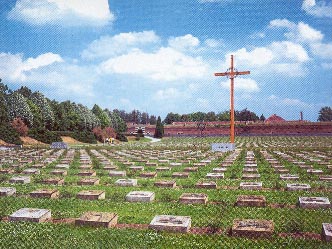
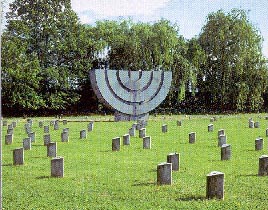
The fortified town of Terezín (German Theresienstadt), built by the Empress Maria
Theresa, from whom it takes its name, and Joseph II, lies on the lower course of the Ohře
a few km above its junction with the Labe (Elbe) at Litoměřice. The town, built within
a period of less than ten years (1780 - 1787), is a textbook example of a planned town in
the Empire and neoclassical manner of the late 18th century. The massive fortification
designed by General Pellegrini werw abandoned in 1887, and Terezín remained merely a
garrison town. The Little Fort (Malá Pevnost) to the east of town was used from the midlle
19th century as a state prison among those confined here by the Austro - Hungarien
authorities were the Greek freedom fighter Alexandre Ypsilanti (died 1828) and Gavrilo
Princip (1918), who assassinated Archduke Francis Ferdinand at Sarajevo in 1914. Durind
the Second World War Theresienstadt gained tragic celebrity when the town became a ghetto
into which Czech Jews were herded and the Little Fort, at first used as a police prison
by the Prague Gestapo, became one of the most illfamed of the German concetration camps.
From 1940 onwards an estimated total of over 150 000 Jews from all over Europe were sent
to this camp, from which regular convoys went to the extermination camps, mainly to
Auschwitz (Os´wiecim in Poland).
The trip to Terezín includes a visit of Museum of Ghetto, Krematorium, Small Fortress.
Since the end of Second World War Little Fort has been an antifascist memorial, a
concentration camp museum. Outside the entrance to the Little Fort is a large impressive
cemetery with the graves of some 26 000 victims of Nazis. On the spot where the ashes of
over 20 000 cremated Jews were scattered in 1944 is the conspicuous Menorah Memorial.
For those of you who like in silent respect commemmorate innocent
victims died during WW II, we can this trip recommend as a very enlightening excursion.
home
|
